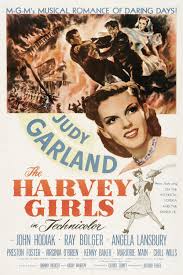Anne Marie is tracking Judy Garland's career through musical numbers...
 Though we last left Judy Garland in 1944 crooning from a trolley and cementing a (troubled) place in Hollywood history, this week we must catapult two years into the future to rejoin our musical heroine. The reason has to do with the odd nature of the Studio System in general and this series in specific. Judy Garland actually shot two movies between 1944 and 1945, but because one was delayed due to reshoots (therefore getting bumped to next week) and the other was a straight drama (therefore not fitting a series focused on musical numbers), we must travel through the end of WW2 and the beginning of Judy Garland's marriage to Vincente Minnelli. Thus, in 1946 we arrive in... the Old West?
Though we last left Judy Garland in 1944 crooning from a trolley and cementing a (troubled) place in Hollywood history, this week we must catapult two years into the future to rejoin our musical heroine. The reason has to do with the odd nature of the Studio System in general and this series in specific. Judy Garland actually shot two movies between 1944 and 1945, but because one was delayed due to reshoots (therefore getting bumped to next week) and the other was a straight drama (therefore not fitting a series focused on musical numbers), we must travel through the end of WW2 and the beginning of Judy Garland's marriage to Vincente Minnelli. Thus, in 1946 we arrive in... the Old West?
The Movie: The Harvey Girls (1946)
The Songwriters: Johnny Mercer (lyrics), Harry Warren (music)
The Players: Judy Garland, Angela Lansbury, Ray Bolger, Cyd Charisse, & John Hodiak, directed by George Sidney
The Story: In 1946, Judy Garland hopped off the trolley and onto a train for a Western-style musical entitled The Harvey Girls. I have to admit, while this is by no means Judy Garland's best musical, it remains a personal favorite for three reasons:
1) Judy Garland sings on a train.
2) It's a musical western genre mashup that misses Oklahoma! by three years and and one saloon fight.
3) Angela Lansbury plays a chorus girl/prostitute named Em. In fact, the movie is a veritable Who's Who of MGM & the Freed Unit, since it also stars baby Cyd Charisse, the return of former Scarecrow Ray Bolger, deadpan alto Virginia O'Brien, and the delightful dulcet tones of Marjorie Main and Chill Wills!
More importantly for Judy, though, this movie shows the Freed Unit's ability to find a winning formula for its tiny Technicolor titan and stick to it. Like Meet Me in St. Louis before it (and many Freed films after it), The Harvey Girls was a musical that leaned heavily on nostalgia; a period piece mixing authentic songs - conveniently taken from the MGM catalogue - with new insta-classics provided by a rotating stable of songwriters. The plots of each of these movies revolves around Judy meeting, loathing, then learning to love a confounded-but-charismatic man; providing ample opportunity for musical numbers, slapstick, and a brightly-colored battle of the sexes. Though this decision may seem limiting, it also further defined Judy Garland at MGM: Judy's image would embrace the tension between modern stardom and nostalgic Americana, a potent symbol of post-war America.